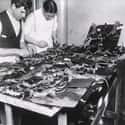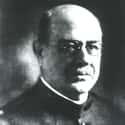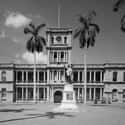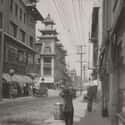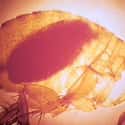-
(#11) The Second Outbreak Was Dealt With Far More Efficiently
While the second outbreak of plague hit San Francisco just two short years after the first one, it was handled much more quickly. Scientific advancements meant people better understood the plague's transmission, and instead of quarantining infected people, Dr. Joseph Kinyoun's replacement, Dr. Rupert Blue, targeted the rats. They were rounded up in great rat-catching efforts thanks to financial bounties, which ultimately prevented some of the spread and allowed scientists to test and kill infected rats.
Not only was the threat identified before the plague's second time around, but the city government also could no longer scapegoat the Chinese residents of the city: all the victims of the second plague were white. Though anti-Chinese sentiment was still prominent, the blame couldn't be shifted — it wasn't miasma, diet, or any xenophobic cause, which meant it had to be dealt with scientifically and medically.
-
(#7) The City Ran A Defamation Campaign Against The Officer Who Discovered The Outbreak
Dr. Joseph James Kinyoun was the leader of the plague eradication movement, but, due to both concentrated misinformation efforts and lack of scientific information, his plans to stop the plague were thwarted. Kinyoun was unsure how to curtail the plague's spread, and he ineffectively quarantined Chinatown in the hopes that it would keep the infection isolated. When animals were infected with the disease and didn't immediately die, the quarantine was lifted, and the city government, particularly Governor Henry Gage, seized on it as proof that Kinyoun had no idea what he was doing. He warned that shipments of goods could spread the illness out of San Francisco and around the country, leading to other states refusing to accept goods from California.
Gage responded to the lost profits by claiming Kinyoun himself had created the plague by injecting Chinese corpses. Furthermore, he stoked the flames of the poor treatment Chinese people were receiving by encouraging them to fight back. Combined with Kinyoun's reportedly uptight demeanor, which did not mesh well with the Chinese population he was meant to be helping, his efforts were undercut, and he was eventually transferred. The plague raged on until Dr. Rupert Blue replaced Kinyoun and shifted the treatment from quarantine to pest eradication.
-
(#13) Honolulu's Chinatown Burned To The Ground When Authorities Attempted To Eradicate The Plague
The plague resurfaced in China on the backs of rats in the 1850s and wound up in Hong Kong. Chinese immigrants and imports often passed this way en route to San Franciso via port stopovers in Hawaii. Following one ship's stop in Hawaii in 1899, a case of the plague broke out in the Honolulu Chinatown, spreading quickly to four more people. In an attempt to contain the plague and eradicate the conditions fostering its rapid spread, The Hawaii Board of Health isolated the victims and quarantined 14 blocks of the area complete with military guards. According to historical record, "To clear contaminated areas, the Board set 41 controlled fires, cleaned and disinfected buildings, burned garbage, filled old cesspools and dug new ones."
However, when this failed to quell the problem and new cases of the plague arose, the Board set another fire which quickly spun out of control and resulted in all of Honolulu's Chinatown burning to the ground. The problematic ships nonetheless continued to San Francisco where, because people on the ships did not show plague symptoms, they were allowed to dock. Along with humans also disembarked infected rats, carrying the disease straight into the port city.
-
(#3) The Outbreak Centered On San Francisco's Chinatown District
San Francisco's plague outbreak was concentrated in the Chinatown district, just a few blocks from what is now the Port of San Francisco. Because Chinatown was particularly overpopulated, had poor sanitation, and had many people living in poor conditions, those features were blamed for the outbreak rather than the actual cause: flea-ridden rats brought from plague-stricken China on the ships that came to the harbor. Instead of treating the cause, the city quarantined its Chinese residents.
But quarantines don't stop rats, and the disease continued to spread outside of the quarantined zones. Because conditions were poor, and racism was rampant, the quarantined residents didn't get proper medical treatment. Thus, the concentration of infected people, fleas, and rats could grow, leading to even more infections.
-
(#5) Racism Was Undoubtedly A Factor In The Plague's Outbreak
The plague itself was a problem, but anti-immigrant sentiment and racism against Chinese people exacerbated the issue. Around this same time, the Chinese Exclusion Act, which prevented Chinese people who were not merchants from immigrating to the US, was extended. Rampant, unfounded anti-Chinese sentiment promoted racist policy, which in turn validated racist viewpoints because of state-sanctioned rules.
In the initial quarantine, white people in Chinatown were told to leave while Chinese residents were forced to stay. Miasma theory, which posited the disease was spread via contact with contaminated air, was blamed for the plague in Chinatown.
Rather than the poor sanitation being a symptom of the area's poverty, it was instead said to be evidence that the Chinese people themselves were the problem. Some went so far as to claim that a rice-based diet made them susceptible to the plague.
-
(#2) The First San Francisco Plague Victim Was A Chinese Immigrant
The first person to die in the San Francisco plague was Wong Chut King, a lumber salesman and Chinese immigrant who was found unconscious in the flophouse where he lived after suffering an intense fever. In a morbidly preemptive move, he was brought to a nearby coffin shop where he died.
Examination of his body revealed swollen lymph nodes — called buboes, hence the disease's name — consistent with a plague infection, as well as an insect bite. Flea transmission was not yet a popular theory to explain plague infection, so while it was noted, the report did nothing to quell the subsequently rampant xenophobic explanations for the disease. When microscopic investigation revealed plague bacteria in Wong Chut King's blood, Chinatown was quarantined to stop the spread, though the fleas and rats that carried the disease were not hindered by arbitrary barriers.
New Random Displays Display All By Ranking
About This Tool
The bubonic plague is one of the most deadly disasters in human history. From the 14th century until the early 19th century, the bubonic plague ravaged Europe and killed about a quarter of the population. In the early 20th century, the disease spread to San Francisco, although the US government attached great importance to the infectious disease, the plague in San Francisco was more lethal than it should have been.
The doctors fabricated that the disease would only appear in Asians and that whites would not be infected. Finally, the plague spread to all of San Francisco. The U.S. government still refused to recognize the outbreak of the plague. The random tool introduced 13 details about the outbreak of the bubonic plague in San Francisco in the 1900s.
Our data comes from Ranker, If you want to participate in the ranking of items displayed on this page, please click here.











